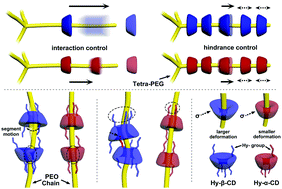Hydroxypropyl-β-CD vs. its α-homologue for a 3D modified polyrotaxane network formation and properties: the relationship between modified CD and polymer revealed through comparison†
Abstract
The threading mechanism of the hydroxypropyl-cyclodextrin (Hy-CD)/tetrahedron-like poly(ethylene glycol) (tetra-PEG) based host–guest complex and the relationship between Hy-CD and poly(ethylene oxide) (PEO) in the three-dimensional modified polyrotaxane (PR) formed by the complex were revealed through the comparison between Hy-β-CD/tetra-PEG and Hy-α-CD/tetra-PEG based systems from the macroscopic material view to the microscopic molecular view. The complexation between Hy-CD and tetra-PEG in water experiences a threading–dethreading–rethreading process which is controlled by the intermolecular interaction intensity or molecular hindrance depending on the feed ratio of Hy-CD to tetra-PEG. In the 3D modified PR, the methyl group of the Hy part on one Hy-CD can insert into the cavity of the adjacent Hy-CD and interacts with both the interior surface of the cavity and the PEO segment within the cavity if the cavity of Hy-CD is large enough. The threaded Hy-CD in the PR straightens the chain of PEO and suppresses the segment motion of the PEO. With the decrease of the cavity size of Hy-CD, the degree of suppression on the segment motion of PEO increases. Hy-CD threaded on the PEO chain can also deform when the 3D modified PR is compressed, and the degree of deformation increases with the increase of the cavity size of Hy-CD. These results of the modified CD/PEG based complex system set it apart from the unmodified CD/PEG based one, and reveal the structure–property relationship of this new type of Hy-CD/tetra-PEG based 3D modified PR material.


 Please wait while we load your content...
Please wait while we load your content...